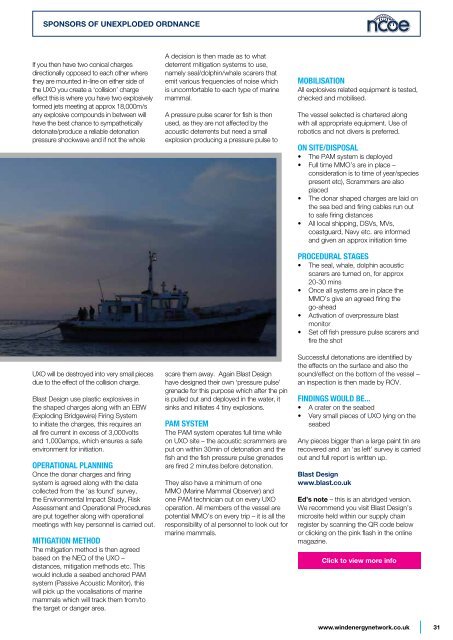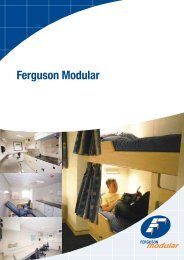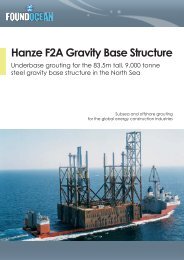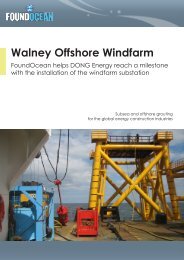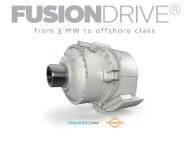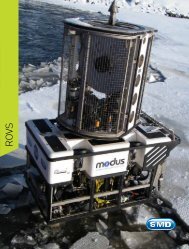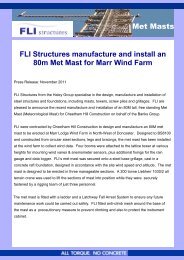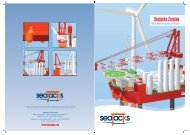UNEXPLODED ORDNANCE - Wind Energy Network
UNEXPLODED ORDNANCE - Wind Energy Network
UNEXPLODED ORDNANCE - Wind Energy Network
Create successful ePaper yourself
Turn your PDF publications into a flip-book with our unique Google optimized e-Paper software.
SPONSORS OF Unexploded Ordnance<br />
If you then have two conical charges<br />
directionally opposed to each other where<br />
they are mounted in-line on either side of<br />
the UXO you create a ‘collision’ charge<br />
effect this is where you have two explosively<br />
formed jets meeting at approx 18,000m/s<br />
any explosive compounds in between will<br />
have the best chance to sympathetically<br />
detonate/produce a reliable detonation<br />
pressure shockwave and if not the whole<br />
UXO will be destroyed into very small pieces<br />
due to the effect of the collision charge.<br />
Blast Design use plastic explosives in<br />
the shaped charges along with an EBW<br />
(Exploding Bridgewire) Firing System<br />
to initiate the charges, this requires an<br />
all fire current in excess of 3,000volts<br />
and 1,000amps, which ensures a safe<br />
environment for initiation.<br />
Operational Planning<br />
Once the donar charges and firing<br />
system is agreed along with the data<br />
collected from the ‘as found’ survey,<br />
the Environmental Impact Study, Risk<br />
Assessment and Operational Procedures<br />
are put together along with operational<br />
meetings with key personnel is carried out.<br />
Mitigation method<br />
The mitigation method is then agreed<br />
based on the NEQ of the UXO –<br />
distances, mitigation methods etc. This<br />
would include a seabed anchored PAM<br />
system (Passive Acoustic Monitor), this<br />
will pick up the vocalisations of marine<br />
mammals which will track them from/to<br />
the target or danger area.<br />
A decision is then made as to what<br />
deterrent mitigation systems to use,<br />
namely seal/dolphin/whale scarers that<br />
emit various frequencies of noise which<br />
is uncomfortable to each type of marine<br />
mammal.<br />
A pressure pulse scarer for fish is then<br />
used, as they are not affected by the<br />
acoustic deterrents but need a small<br />
explosion producing a pressure pulse to<br />
scare them away. Again Blast Design<br />
have designed their own ‘pressure pulse’<br />
grenade for this purpose which after the pin<br />
is pulled out and deployed in the water, it<br />
sinks and initiates 4 tiny explosions.<br />
PAM system<br />
The PAM system operates full time while<br />
on UXO site – the acoustic scrammers are<br />
put on within 30min of detonation and the<br />
fish and the fish pressure pulse grenades<br />
are fired 2 minutes before detonation.<br />
They also have a minimum of one<br />
MMO (Marine Mammal Observer) and<br />
one PAM technician out on every UXO<br />
operation. All members of the vessel are<br />
potential MMO’s on every trip – it is all the<br />
responsibility of al personnel to look out for<br />
marine mammals.<br />
Mobilisation<br />
All explosives related equipment is tested,<br />
checked and mobilised.<br />
The vessel selected is chartered along<br />
with all appropriate equipment. Use of<br />
robotics and not divers is preferred.<br />
On Site/Disposal<br />
• The PAM system is deployed<br />
• Full time MMO’s are in place –<br />
consideration is to time of year/species<br />
present etc), Scrammers are also<br />
placed<br />
• The donar shaped charges are laid on<br />
the sea bed and firing cables run out<br />
to safe firing distances<br />
• All local shipping, DSVs, MVs,<br />
coastguard, Navy etc. are informed<br />
and given an approx initiation time<br />
Procedural stages<br />
• The seal, whale, dolphin acoustic<br />
scarers are turned on, for approx<br />
20-30 mins<br />
• Once all systems are in place the<br />
MMO’s give an agreed firing the<br />
go-ahead<br />
• Activation of overpressure blast<br />
monitor<br />
• Set off fish pressure pulse scarers and<br />
fire the shot<br />
Successful detonations are identified by<br />
the effects on the surface and also the<br />
sound/effect on the bottom of the vessel –<br />
an inspection is then made by ROV.<br />
Findings would be...<br />
• A crater on the seabed<br />
• Very small pieces of UXO lying on the<br />
seabed<br />
Any pieces bigger than a large paint tin are<br />
recovered and an ‘as left’ survey is carried<br />
out and full report is written up.<br />
Blast Design<br />
www.blast.co.uk<br />
Ed’s note – this is an abridged version.<br />
We recommend you visit Blast Design’s<br />
microsite held within our supply chain<br />
register by scanning the QR code below<br />
or clicking on the pink flash in the online<br />
magazine.<br />
Click to view more info<br />
www.windenergynetwork.co.uk<br />
31


